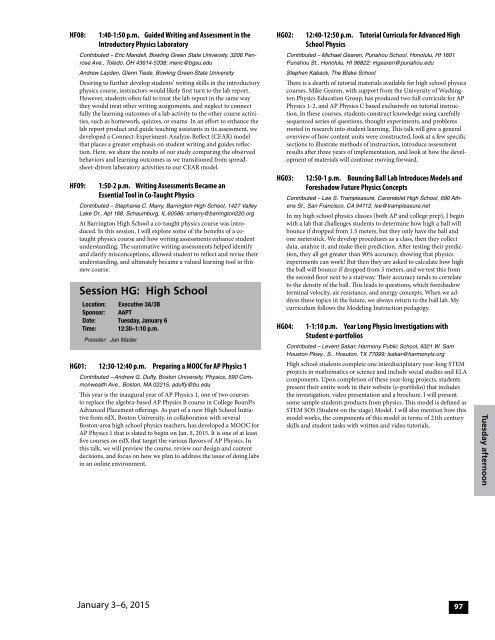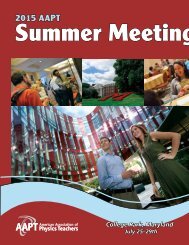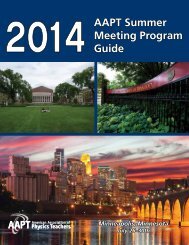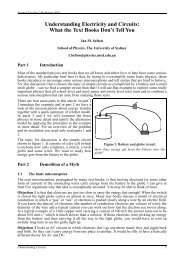final-program-12-23-14-3
final-program-12-23-14-3
final-program-12-23-14-3
You also want an ePaper? Increase the reach of your titles
YUMPU automatically turns print PDFs into web optimized ePapers that Google loves.
HF08: 1:40-1:50 p.m. Guided Writing and Assessment in the<br />
Introductory Physics Laboratory<br />
Contributed – Eric Mandell, Bowling Green State University, 3206 Penrose<br />
Ave., Toledo, OH 436<strong>14</strong>-5338; meric@bgsu.edu<br />
Andrew Layden, Glenn Tiede, Bowling Green State University<br />
Desiring to further develop students’ writing skills in the introductory<br />
physics course, instructors would likely first turn to the lab report.<br />
However, students often fail to treat the lab report in the same way<br />
they would treat other writing assignments, and neglect to connect<br />
fully the learning outcomes of a lab activity to the other course activities,<br />
such as homework, quizzes, or exams. In an effort to enhance the<br />
lab report product and guide teaching assistants in its assessment, we<br />
developed a Connect-Experiment-Analyze-Reflect (CEAR) model<br />
that places a greater emphasis on student writing and guides reflection.<br />
Here, we share the results of our study comparing the observed<br />
behaviors and learning outcomes as we transitioned from spreadsheet-driven<br />
laboratory activities to our CEAR model.<br />
HF09:<br />
1:50-2 p.m. Writing Assessments Became an<br />
Essential Tool in Co-Taught Physics<br />
Contributed – Stephanie C. Marry, Barrington High School, <strong>14</strong>27 Valley<br />
Lake Dr., Apt 168, Schaumburg, IL 60586; smarry@barrington220.org<br />
At Barrington High School a co-taught physics course was introduced.<br />
In this session, I will explore some of the benefits of a cotaught<br />
physics course and how writing assessments enhance student<br />
understanding. The summative writing assessments helped identify<br />
and clarify misconceptions, allowed student to reflect and revise their<br />
understanding, and ultimately became a valued learning tool in this<br />
new course.<br />
Session HG: High School<br />
Location: Executive 3A/3B<br />
Sponsor: AAPT<br />
Date: Tuesday, January 6<br />
Time: <strong>12</strong>:30–1:10 p.m.<br />
Presider: Jan Mader<br />
HG01: <strong>12</strong>:30-<strong>12</strong>:40 p.m. Preparing a MOOC for AP Physics 1<br />
Contributed – Andrew G. Duffy, Boston University, Physics, 590 Commonwealth<br />
Ave., Boston, MA 02215; aduffy@bu.edu<br />
This year is the inaugural year of AP Physics 1, one of two courses<br />
to replace the algebra-based AP Physics B course in College Boards<br />
Advanced Placement offerings. As part of a new High School Initiative<br />
from edX, Boston University, in collaboration with several<br />
Boston-area high school physics teachers, has developed a MOOC for<br />
AP Physics 1 that is slated to begin on Jan. 5, 2015. It is one of at least<br />
five courses on edX that target the various flavors of AP Physics. In<br />
this talk, we will preview the course, review our design and content<br />
decisions, and focus on how we plan to address the issue of doing labs<br />
in an online environment.<br />
HG02: <strong>12</strong>:40-<strong>12</strong>:50 p.m. Tutorial Curricula for Advanced High<br />
School Physics<br />
Contributed – Michael Gearen, Punahou School, Honolulu, HI 1601<br />
Punahou St., Honolulu, HI 96822; mgearen@punahou.edu<br />
Stephen Kaback, The Blake School<br />
There is a dearth of tutorial materials available for high school physics<br />
courses. Mike Gearen, with support from the University of Washington<br />
Physics Education Group, has produced two full curricula for AP<br />
Physics 1-2, and AP Physics C based exclusively on tutorial instruction.<br />
In these courses, students construct knowledge using carefully<br />
sequenced series of questions, thought experiments, and problems<br />
rooted in research into student learning. This talk will give a general<br />
overview of how content units were constructed, look at a few specific<br />
sections to illustrate methods of instruction, introduce assessment<br />
results after three years of implementation, and look at how the development<br />
of materials will continue moving forward.<br />
HG03: <strong>12</strong>:50-1 p.m. Bouncing Ball Lab Introduces Models and<br />
Foreshadow Future Physics Concepts<br />
Contributed – Lee S. Trampleasure, Carondelet High School, 690 Athens<br />
St., San Francisco, CA 941<strong>12</strong>; lee@trampleasure.net<br />
In my high school physics classes (both AP and college prep), I begin<br />
with a lab that challenges students to determine how high a ball will<br />
bounce if dropped from 1.5 meters, but they only have the ball and<br />
one meterstick. We develop procedures as a class, then they collect<br />
data, analyze it, and make their prediction. After testing their prediction,<br />
they all get greater than 90% accuracy, showing that physics<br />
experiments can work! But then they are asked to calculate how high<br />
the ball will bounce if dropped from 5 meters, and we test this from<br />
the second floor next to a stairway. Their accuracy tends to correlate<br />
to the density of the ball. This leads to questions, which foreshadow<br />
terminal velocity, air resistance, and energy concepts. When we address<br />
these topics in the future, we always return to the ball lab. My<br />
curriculum follows the Modeling Instruction pedagogy.<br />
HG04: 1-1:10 p.m. Year Long Physics Investigations with<br />
Student e-portfolios<br />
Contributed – Levent Sakar, Harmony Public School, 9321 W. Sam<br />
Houston Pkwy., S., Hosuton, TX 77099; lsakar@harmonytx.org<br />
High school students complete one interdisciplinary year-long STEM<br />
projects in mathematics or science and include social studies and ELA<br />
components. Upon completion of these year-long projects, students<br />
present their entire work in their website (e-portfolio) that includes<br />
the investigation, video presentation and a brochure. I will present<br />
some sample students products from physics. This model is defined as<br />
STEM SOS (Student on the stage) Model. I will also mention how this<br />
model works, the components of this model in terms of 21th century<br />
skills and student tasks with written and video tutorials.<br />
Tuesday afternoon<br />
January 3–6, 2015<br />
97






